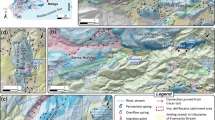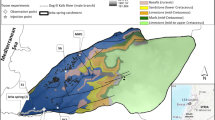Abstract
The existence of double-peaked breakthrough curves (BTC), which are the result of the transport of a dye tracer through underground lakes, is reported. Investigations were undertaken on the Furfooz karst system in southern Belgium. In this system, the River Lesse sinks partially into a swallow hole. The water follows a solitary conduit leading to an underground lake that is directly connected to a second underground lake. Double-peaked BTCs were detected in the resurgent water, downstream of this second lake. The report first describes field data (tracer tests in various hydrologic conditions) which point towards the double peak being linked to a nonlinear process that originates within the lakes. Complementary investigations within the lakes show a complex behavior of the dye tracer related to a specific hydrodynamic feature that leads to the separation of the solute plume. A conceptual model of the solute transport within the lakes is proposed. This model emphasizes the physical effect of the lakes on the dye flow-through process.
Résumé
On rapporte l’existence de courbes de restitution à double pics (CR), résultant du transport d’un traceur artificiel (colorant) dans des lacs souterrains. Des études ont été menées sur le système karstique de Furfooz dans le Sud de la Belgique. Dans ce système, la rivière Lesse s’infiltre partiellement dans une perte. L’eau s’écoule au sein d’un conduit unique menant à un lac souterrain qui est directement connecté à un deuxième lac souterrain. Les CR à double pics ont été détectées dans une résurgence, située en aval de ce deuxième lac. Cet article décrit d’abord les données de terrain (essais de traçage dans des conditions hydrologiques diverses) qui indiquent que le double pic est lié à un processus non linéaire qui prend son origine au sein des lacs. Des études complémentaires au niveau des lacs montrent un comportement complexe du traceur artificiel associé à une hydrodynamique spécifique conduisant à la séparation du panache du soluté. Un modèle conceptuel du transport de soluté au sein des lacs est proposé. Ce modèle met l’accent sur l’effet physique des lacs sur les processus de transport du traceur artificiel.
Resumen
Se informa acerca de la existencia de curvas de avance de doble pico (BTC), que son el resultado del transporte de un trazador de colorantes a través de lagos subterráneos. Se realizaron investigaciones sobre el sistema karst de Furfooz en el sur de Bélgica. En este sistema, el río Lesse se hunde parcialmente en pozos kársticos. El agua sigue un conducto único que conduce a un lago subterráneo que está conectado directamente a un segundo lago subterráneo. Se detectaron BTCs de doble pico en el agua resurgente, aguas abajo de este segundo lago. El artículo describe primero los datos de campo (pruebas de trazabilidad en diversas condiciones hidrológicas) que apuntan hacia el doble pico vinculado a un proceso no lineal que se origina dentro de los lagos. Las investigaciones complementarias dentro de los lagos muestran un comportamiento complejo del trazador de colorantes relacionado con una característica hidrodinámica específica que conduce a la separación de la pluma de soluto. Se propone un modelo conceptual del transporte de soluto dentro de los lagos. Este modelo enfatiza el efecto físico de los lagos en el proceso de flujo del colorante.
摘要
报道了双峰突破曲线(BTC)的存在,这是通过地下湖运输染料示踪剂的结果。对比利时南部的Furfooz岩溶系统进行了调查。在这个系统中,River Lesse部分地陷入了一个燕窝。水沿着一条通向直接连接到第二个地下湖泊的地下湖的独立导管。在第二湖下游的复水中检测到双峰BTC。本文首先描述了现场数据(各种水文条件下的示踪剂测试),其指向与峰值起源于湖泊内的非线性过程相关联的双峰。湖中的互补调查显示了染料示踪剂与导致溶质羽流分离的特定流体动力特征相关的复杂行为。提出了湖泊内溶质运输的概念模型。该模型强调了湖泊对染料流通过程的物理效应。
Resumo
Apresenta-se a existência de curvas de identificação de pico duplo como resultado do transporte de um traçador corante através de lagoas subterrâneas. As investigações foram realizadas no sistema cárstico de Furfooz ao sul da Bélgica. Neste sistema o Rio Lesse desaparece parcialmente dentro de uma cavidade rasa. A água segue por um conduto isolado em direção a uma lagoa subterrânea que está diretamente conectada a uma segunda lagoa subterrânea. Curvas de identificação de pico duplo foram detectadas em ressurgências, a jusante da segunda lagoa. O artigo explica em primeiro lugar os dados de campo (testes com traçadores em diversas condições hidrogeológicas) que apontam para o pico duplo associado a um processo não linear que se origina dentro das lagoas. Investigações complementarias dentro das lagoas mostram um comportamento complexo do traçador corante, relacionado a uma característica hidrodinâmica específica que condiciona a separação da pluma de soluto. É proposto um modelo conceitual do transporte de soluto dentro das lagoas. Este modelo enfatiza o efeito físico das lagoas no processo de fluxo do corante.










Similar content being viewed by others
Change history
16 November 2019
There was an error in the fluorimeter data computing for tracer test 1 (Q= 20 l/s) at site 4. Indeed, due to a misinterpretation of the fluorimeter recording, some data should appear as interpolated. This interpolation was based, namely, on the comparison with other tracer test results. Figure 4 is corrected here with the interpolated data appearing as a red dotted line (top graph, see ���interpolated data���). In consequence, the recovery rate (39.9%) calculated in Table 1 is an estimation based on the interpolated data. A note has been added to Table 1.
16 November 2019
There was an error in the fluorimeter data computing for tracer test 1 (Q= 20 l/s) at site 4. Indeed, due to a misinterpretation of the fluorimeter recording, some data should appear as interpolated. This interpolation was based, namely, on the comparison with other tracer test results. Figure 4 is corrected here with the interpolated data appearing as a red dotted line (top graph, see ���interpolated data���). In consequence, the recovery rate (39.9%) calculated in Table 1 is an estimation based on the interpolated data. A note has been added to Table 1.
References
Brouyère S, Rentier C (1997) About the influence of the injection mode on tracer test results. In: Kranjc A (ed) Tracer hydrology 97, Proceedings of the 7th International Symposium on Water Tracing. International Association of Tracer Hydrology (ATH) and Karst Research Institute ZRC SAZU. Balkema, Rotterdam, The Netherlands, pp 11–17
Dewaide L, Bonniver I, Rochez G, Hallet V (2016) Solute transport in heterogeneous karst systems: dimensioning and estimation of transport parameters via multi-sampling tracer tests modelling using the OTIS (one-dimensional transport with inflow and storage) program. J Hydrol 534:567–578
Field MS (2002) The QTRACER2 program for tracer-breakthrough curve analysis for tracer tests in karstic aquifers and other hydrologic systems. EPA/600/R-02/001, US EPA, National Center for Environmental Assessment, Washington, DC
Field MS, Leij F (2012) Solute transport in solution conduits exhibiting multi-peaked breakthrough curves. J Hydrol 440–441:26–35
Field MS, Pinsky PF (2000) A two-region nonequilibrium model for solute transport in solution conduits in karstic aquifers. J Contam Hydrol 44(3/4):329–351
Goldscheider N, Meiman J, Pronk M, Smart C (2008) Tracer tests in karst hydrogeology and speleology. Int J Speleol 37(1):27–40
Grey WG, Pinder GF (1976) An analysis of the numerical solution of the transport equation. Water Resour Res 12(3):547–555
Hauns M, Jeannin P-Y (1998) Tracer transport in underground rivers in karst: tailing effects and channel geometry. Bull Hydrogéol 16:123–142
Hauns M, Jeannin P-Y, Atteia O (2001) Dispersion, retardation and scale effect in tracer breakthrough curves in karst conduits. J Hydrol 241(3–4):177–193
Jeannin P-Y, Groves C, Häuselmann P (2007) Speleological investigations. In: Goldscheider N, Drew D (eds) Methods in karst hydrogeology international contributions to hydrogeology. Taylor and Francis, London, pp 25–44
Käss W (1998) Tracing technique in geohydrology. Balkema, Rotterdam, The Netherlands, 600 pp
Landau LD, Lifshitz EM (1987) Fluid mechanics, 2nd edn. Pergamon, Oxford, UK, 558 pp
Maloszewski P, Harum T, Benischke R (1992) Mathematical modelling of tracer experiments in the karst of Lurbach system. In: Himmelsbach T, Hötzl H, Käss W, Leibundgut C, Maloszewski P, Meyer T, Moser H, Rajner V, Rank D, Stichler W, Trimborn P, Veulliet E (eds) Application of tracer models, Steirische Beiträge zur Hydrogeologie [Styrian contribution to hydrogeologie], 6th International Symposium on Water Tracing: Transport Phenomena in Different Aquifers (investigations 1987–1992), vol 43. Joanneum, Graz, Austria, pp 116–158
Massei N, Wang HQ, Field MS, Dupont JP, Bakalowicz M, Rodet J (2006) Interpreting tracer breakthrough tailing in a conduit-dominated karst aquifer. Hydrogeol J 14(6):849–858
Morales T, Uriarte JA, Olazar M, Antigüedad I, Angulo B (2010) Solute transport modelling in karst conduits with slow zones during different hydrologic conditions. J Hydrol 390:182–189
Poulain A, Rochez G, Van Roy JP, Dewaide L, Hallet V, De Sadelear G (2017) A compact field fluorometer and its application for dye tracing in karst environments. Hydrogeol J. https://doi.org/10.1007/s10040-017-1577-1
Schnegg PA, Doerfliger N (1997) An inexpensive flow-through field fluorometer. Proceedings of the 6th Conference on Limestone Hydrology and Fissured Media, la Chaux-de-Fonds, vol 2. Centre of Hydrogeology, University of Neuchatel, Neuchatel, Switzerland, pp 47–50
Schudel B, Biaggi D, Dervey T, Kozel R, Müller I, Ross JH, Schindler U (2003) Application of artificial tracers in hydrogeology: guideline. Bull Hydrogéol, 20(Spec Issue):1–91
Werner A, Hötlz H, Maloszewski P, Käss W (1997) Interpretation of tracer tests in karst systems with unsteady flow conditions. In: Leibundgut C, Gunn J, Dassargues A (eds) Karst hydrology: proceedings of an international workshop held at Rabat, Morocco during the Fifth Scientific Assembly of the IAHS (23 April to 3 May 1997), IAHS Pub. no. 247, IAHS, Wallingford, UK, pp 15–26
Acknowledgements
The authors would like to thank the “Ardennes et Gaume” NPO for giving us access to the Furfooz Natural Reserve. Special thanks goes to Michel Pauwels, an experienced diver, whose precious information helped us to build the conceptual model and who was brave enough to take the casing to the bottom of the lake. The authors are grateful to the reviewers, in particular to Malcolm Field, whose remarks improved the quality of this report.
Author information
Authors and Affiliations
Corresponding author
Rights and permissions
About this article
Cite this article
Dewaide, L., Collon, P., Poulain, A. et al. Double-peaked breakthrough curves as a consequence of solute transport through underground lakes: a case study of the Furfooz karst system, Belgium. Hydrogeol J 26, 641–650 (2018). https://doi.org/10.1007/s10040-017-1671-4
Received:
Accepted:
Published:
Issue Date:
DOI: https://doi.org/10.1007/s10040-017-1671-4




